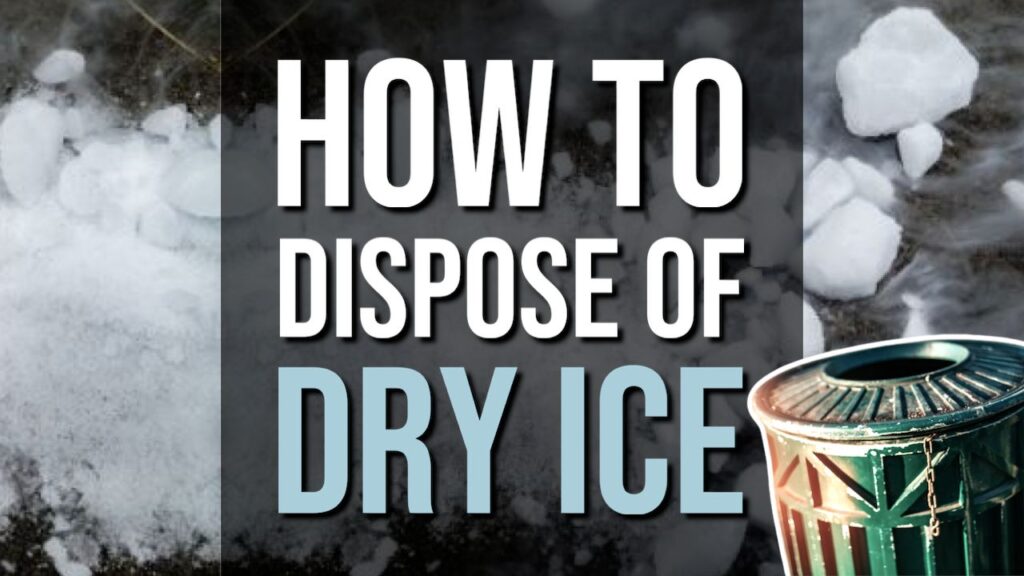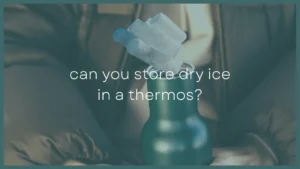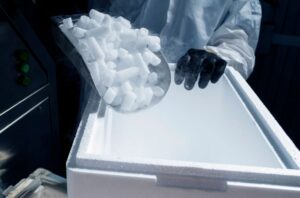If you've found yourself with some dry ice that you have no real use for you may be wondering how to dispose of it safely.
Dry ice is frozen carbon dioxide and it's extremely cold. At -109ºF (-78ºC) it's so cold that it can burn your skin if you touch it and it lets off carbon dioxide gas, which if not vented properly, can be dangerous.
So how do you safely dispose of dry ice?
Dry ice is actually quite simple to dispose of and if you follow some simple guidelines it'll be gone in no time.
To safely dispose of dry ice simply leave it outside or in a well ventilated space and it will turn to gas and disappear. Don't dispose of dry ice in the sink or toilet as it can freeze the water in your pipes cracking them.
You can also speed up the process of getting rid of dry ice by breaking it into smaller pieces or by putting it in warm or hot water.
It's not too different from melting regular ice, except dry ice turns to gas and blows away, there is no water or liquid left to clean up.
Disposing Of Dry Ice Is All About Letting It Turn Into Gas And Disappear
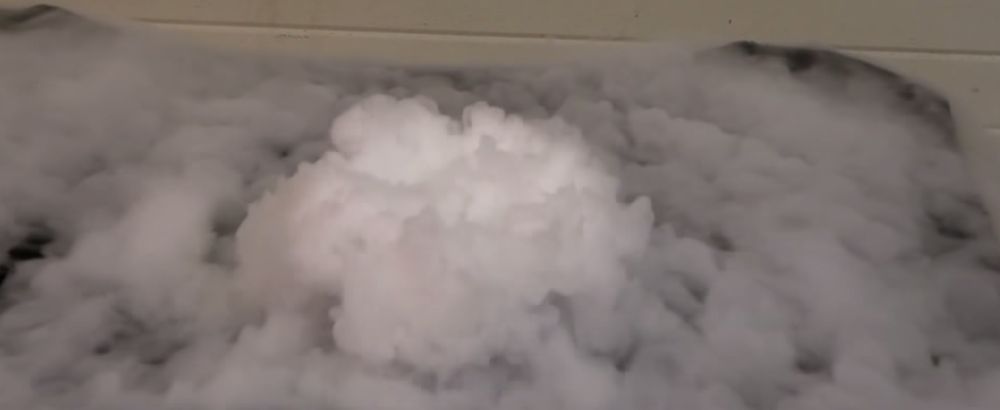
When it comes down to it disposing of dry ice is less about finding a place to “dispose” of it (eg. a trash can, chemical waste bin, flushing down the toilet etc) and more just about putting it in a place where it can safely turn from a solid into a gas and disappear.
Dry ice is frozen carbon dioxide. It's colder than ice but it doesn't melt like ice.
Instead it sublimates, meaning it turns from a solid directly into a gas.
Just like if you leave regular ice at room temperature it will eventually all melt into water with dry ice if you leave it at room temperature it'll eventually all turn into gas.
Once this is done the gas will be blown away and your dry ice will disposed of.
So all the below methods of disposing of dry ice are all about letting it turn from a solid to a gas in a safe way.
How To Dispose Of Dry Ice Safely
So how exactly can you dispose of dry ice? Below are 6 methods for easily getting rid of dry ice so you don't have to worry about it anymore.
1. Leave It Outside To Turn Into Gas

Leaving dry ice outside to naturally warm up and sublimate into a gas is one of the easiest and safest ways to dispose of dry ice.
Being outside guarantees the area is well ventilated and there won't be a build up of carbon dioxide.
It's generally a good idea to put it in something like a cardboard box or an open cooler so it doesn't kill your grass and so no people or animals touch it by accident.
Just make sure whatever you put it in isn't air tight so the gas has a way to escape.
Can I Leave Dry Ice Outside?
Yes you can leave dry ice outside and it's one of the best ways to get rid of it. The dry ice will naturally turn into a gas and be blown away in the wind, leaving no remains behind.
2. Leave It Inside To Turn Into Gas But Ensure Good Airflow

If you don't want to take it outside or you live in an apartment building without a safe outside space to put the dry ice then you can get rid of it inside.
It will naturally turn to gas over time so you don't need to do anything special to get rid of it.
You do however need to make sure that whatever inside space the dry ice is in is well ventilated. Open the doors or the windows and ensure some good airflow.
If you don't do this the room can fill up with too much carbon dioxide gas which can be dangerous.
Is Dry Ice Gas Dangerous?
Dry ice gas is carbon dioxide which is naturally in all the air we breath and is also what is used to make soda and other drinks fizzy. When dry ice gas gets dangerous is in unventilated and enclosed spaces where it can build up to toxic levels.
Dry ice fills the space with carbon dioxide gas which when inhaled in large quantities can displace oxygen in the body which can lead to harmful effects like headaches, confusion, disorientation and ultimately death.
3. Use Hot Water To Make It Melt Faster (And Make a Cool Fog Effect)
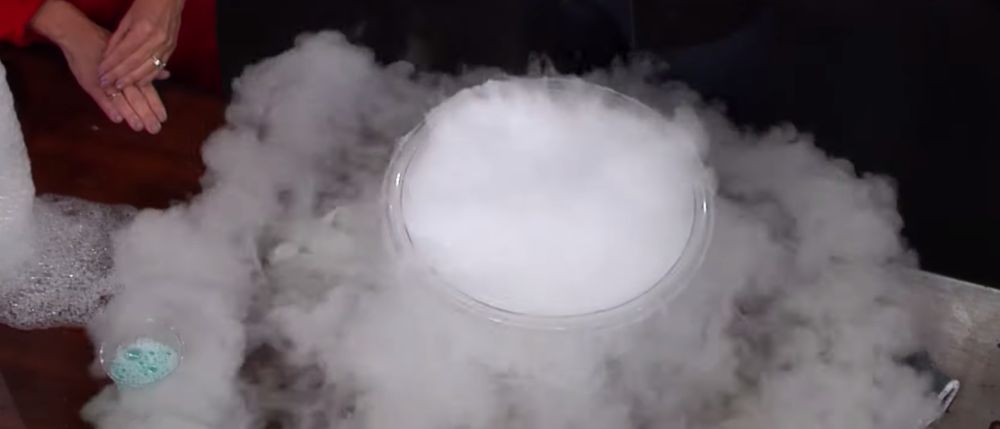
If you don't want to just sit around and wait for the dry ice to melt then you can speed up the process by using warm water.
Water is much more effective than air at transferring heat and so putting dry ice in hot water will cause it to sublimate into gas much much faster.
Putting dry ice in a boiling pot of water on the stove is one of the fastest ways to dispose of it.
If you don't want to do that then a bowl or bucket of warm water can do the trick.
Over time the dry ice will make the water cold and may even freeze it. So you may need to tip out the cold water and top up with more warm water.
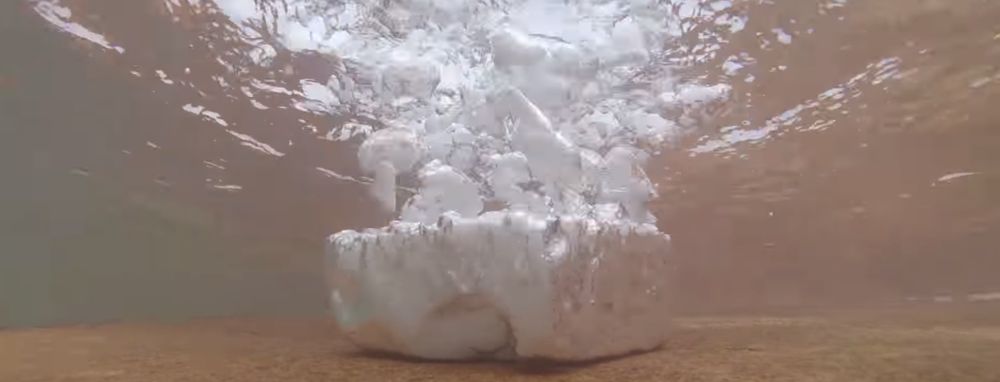
Even cold or room temperature water is hot compared to dry ice and will speed up the process of the dry ice disappearing. More on how long dry ice lasts in water.
Don't put dry ice in your sink or somewhere where it can freeze the water in your pipes and this will lead to your pipes potentially cracking and a really expensive plumbing bill.
4. Break Up The Dry Ice So It Sublimates Faster
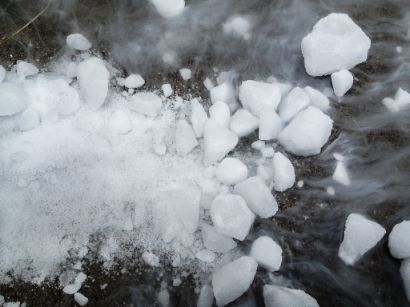
If you want the dry ice to disappear quicker then breaking into smaller pieces will cause it to turn into gas and disappear faster.
Just make sure you wear gloves and safety glasses if you're breaking up the dry ice.
It's so cold it can burn your skin and if it gets in your eye it can burn your eye and blind you.
5. Use a Cooler To Dispose of Dry Ice Slowly

If you want to make your dry ice last as long as possible then placing it in a high quality cooler will keep it insulated from the warm outside air and it will last longer.
Dry ice can last days in a cooler like Yeti and you can use it to keep food frozen.
It won't last forever in a cooler and eventually it will turn to gas, but the cooler will slow down the process dramatically.
Also make sure your cooler isn't airtight so pressure doesn't build up. Will dry ice explode in a cooler?
6. Put It In Your Freezer (Maybe)
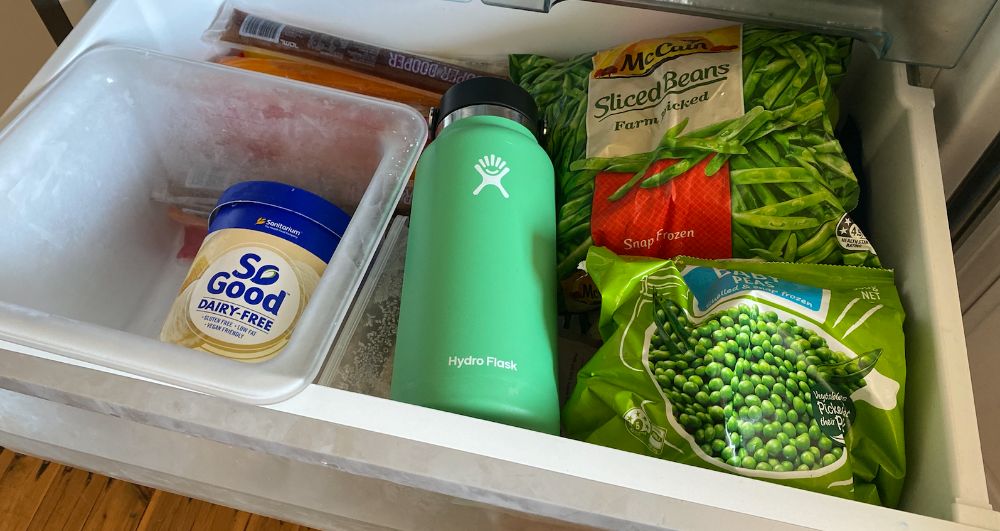
Maybe you don't want the “cold power” of the dry ice to go to waste so you may consider putting it in your freezer to keep food frozen.
In small amount this can be fine, but in large amount it'll likely actually switch off your freezer as the thermostat will register the temperatures as being extremely low.
In bad situations dry ice can actually damage your freezer. For some people it's worth it for others it's not really worth the risk of breaking your freezer. Learn more about if you should put dry ice in your freezer.
How To Dispose of Dry Ice In Plastic Bags
Dry ice often comes in plastic bags that make it easier to handle and have holes so the gas can ventilated.
To dispose of dry ice in plastic bags simply leave the dry ice out to warm up and turn into gas. Once the dry ice is completely gone the plastic bag can be thrown into the trash.
How NOT To Dispose Of Dry Ice + Safety Tips
Really disposing of dry ice is more about what not to do.
Dry ice is so cold that it will burn your skin if you touch it and can lead to frostbite.
It's also so cold that it can freeze water, which can lead to burst sinks, toilets or pipes if you're not careful.
It also turns into carbon dioxide gas and if you inhale too much of this gas it can displace the oxygen in the body and lead to harmful effects. While extremely unlikely dry ice can kill if you're not careful.
So what are some ways not to dispose of dry ice?
Don't Put Dry Ice In Your Sink, Down The Drain or In The Toilet
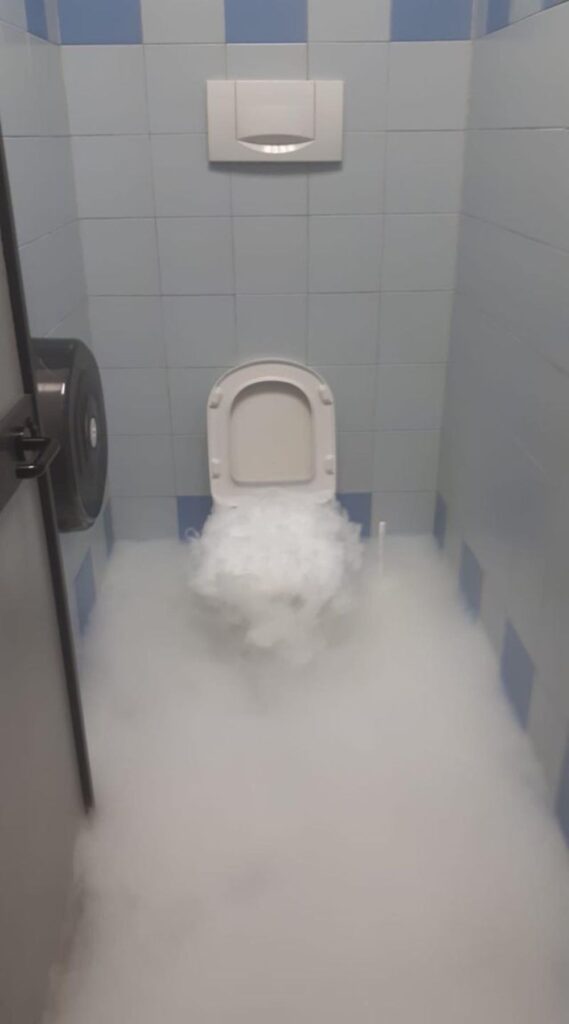
While you might be inclined to flush your dry ice down the toilet or to wash it down the sink this is actually a really bad idea.
Dry ice is so cold that it can make the water in your sink, toilet or pipes completely freeze over.
As you know water expands as it freezes and this if this happens dry ice can crack and burst pipes. More about what to do if you've accidentally put dry ice in your sink.
Don't Leave Dry Ice In An Enclosed Space
Dry ice turns into carbon dioxide gas as it sublimates.
If this is happening in an enclosed space (eg. your car or a small room) and there is no ventilation of air eventually the space will fill up with too much carbon dioxide which can be toxic to you.
So if it's in your car or a small room make sure you open the windows and have good ventilation.
Don't Eat Dry Ice
It kind of goes without saying given dry ice is so cold it can burn but don't be an idiot and don't eat dry ice. Dry ice is not edible.
Don't Put In an Airtight Container
As dry ice turns into gas it expands. If you put dry ice in an airtight container then this expanding gas is going to build up pressure and eventually break the container or even make it explode.
Don't Leave Unattended (Especially Around Kids)
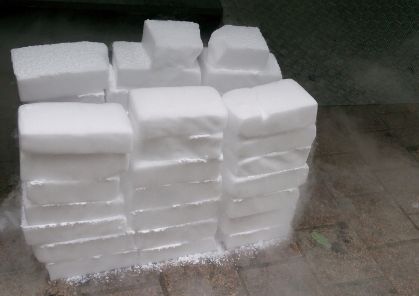
When disposing of dry ice it's advised that you don't leave it unattended, especially around children.
Kids, animals or other people may accidentally touch the dry ice which can cause bodily harm.
So it's a good idea to be around while you get rid of your dry ice or ensure it's in an area where no one will accidentally get to it.
If you're short on time and want to quickly get rid of the dry ice check out my article on how to make dry ice melt quickly.
Safety Precautions

Because dry ice can burn your skin make sure you take safety precautions when handling it.
Ideally wear gloves and use safety glasses if breaking up the dry ice. Keep it outside or in a well ventilated space and you should be fine.
Don't Put on Tiles or Your Countertop
Dry ice is so cold that it can cause some materials like tiles or stone bench tops to crack.
So keep the dry ice away from direct contact with these surfaces. Dry ice safe coolers, styrofoam or cardboard boxes are easy places to store dry ice where it won't break anything.
Don't Throw Dry Ice In The Trash
While you technically can throw dry ice in the trash, as long as it's in a well ventilated room and the bag is completely airtight it's a better idea to dispose of it somewhere where you can see when it's gone.
Out of sight and out of mind can be good for some things but for dry ice in enclosed spaces that usually isn't the case.

